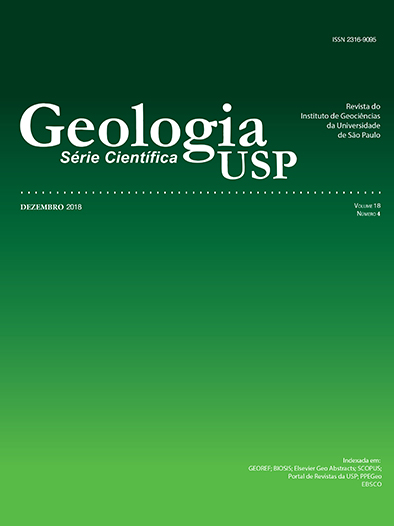Implications of the subfacies and deuteritic alterations identification in the F-rich albite granite at the Madeira Sn-Nb-Ta-ETR deposit (Pitinga Mine, Amazonas, Brazil)
DOI:
https://doi.org/10.11606/issn.2316-9095.v18-142834Keywords:
Albite granite, Deuteric, Hydrothermal, Pitinga, Madeira deposit, AmazonasAbstract
The Pitinga albite granite, located in the State of Amazon, northern Brazil, compositionally ranging from monzogranite to granodiorite, has a complex mineralogical and petrographic diversity due both to magmatic-hydrothermal transition and deuteric alteration processes. Mapping of the north mining front at the contact between the border subfacies (border albite granite) and core subfacies (core albite granite), petrographic description and geochemical analysis of representative samples showed two partially superposed border albite granite alteration paragenesis: the first one is red-brown, characterized by traces of green Fe-rich mica, and the other is red, where this green Fe-rich mica was replaced either by fluorite and chlorite and/or yellow
clay. The porphyritic gray core albite granite is gradually transformed in to a white porphyritic rock richer in albite; to a yellow when argillizedillite and kaolinite rock; locally with red iron oxide spots, silicification and criolitization. As the late quartz (silicification) cryolite shows, primary aqueous fluid inclusions with homogenization temperatures from 100 to 250ºC and salinity up to 26wt. % NaCl eq. Both border albite granite and core albite granite subfacies are cut by irregular aphanitic white rock bodies essentially composed by quartz and white albite. The rare earth elements pattern of these white aphanitic rocks is similar to border albite granite and core albite granite, but with lower total contents, suggesting that they are coeval. The border albite granite subfacies was the first formed during a concentric magmatic chamber cooling process and suffered autometasomatic deuteric alteration creating the red-brown iron oxides. Continuous magma chamber cooling could have created the gray CAG and hydrothermal cryolite massive lens.
Downloads
Downloads
Published
Issue
Section
License
Authors who publish in this journal shall comply with the following terms:
- Authors keep their copyright and grant to Geologia USP: Série Científica the right of first publication, with the paper under the Creative Commons BY-NC-SA license (summary of the license: https://creativecommons.org/licenses/by-nc-sa/4.0 | full text of the license: https://creativecommons.org/licenses/by-nc-sa/4.0/legalcode) that allows the non-commercial sharing of the paper and granting the proper copyrights of the first publication in this journal.
- Authors are authorized to take additional contracts separately, for non-exclusive distribution of the version of the paper published in this journal (publish in institutional repository or as a book chapter), granting the proper copyrights of first publication in this journal.
- Authors are allowed and encouraged to publish and distribute their paper online (in institutional repositories or their personal page) at any point before or during the editorial process, since this can generate productive changes as well as increase the impact and citation of the published paper (See The effect of Open Access and downloads on citation impact).





